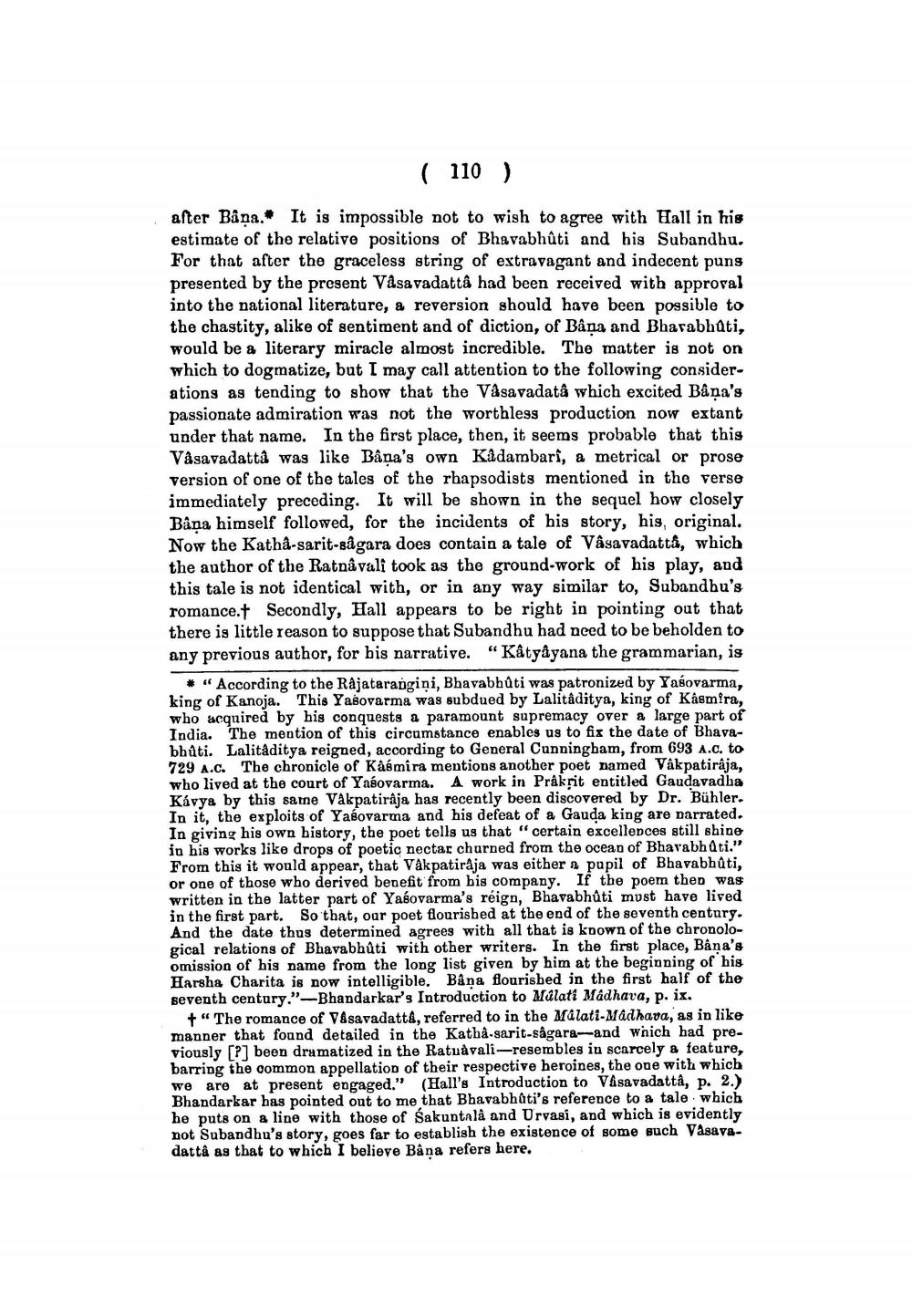________________
( 110 )
after Bâņa. It is impossible not to wish to agree with Hall in his estimate of the relative positions of Bhavabhûti and his Subandhu. For that after the graceless string of extravagant and indecent puns presented by the present Vasavadattâ had been received with approval into the national literature, a reversion should have been possible to the chastity, alike of sentiment and of diction, of Bâna and Bhavabhuti, would be a literary miracle almost incredible. The matter is not on which to dogmatize, but I may call attention to the following considerations as tending to show that the Vâsavadatâ which excited Bâņa's passionate admiration was not the worthless production now extant under that name. In the first place, then, it seems probable that this Vasavadatta was like Bâna's own Kadambarî, a metrical or prose version of one of the tales of the rhapsodists mentioned in the verse immediately preceding. It will be shown in the sequel how closely Bâna himself followed, for the incidents of his story, his, original. Now the Kathâ-sarit-sâgara does contain a tale of Vâsavadattâ, which the author of the Ratnâvali took as the ground-work of his play, and this tale is not identical with, or in any way similar to, Subandhu's romance. Secondly, Hall appears to be right in pointing out that there is little reason to suppose that Subandhu had need to be beholden to any previous author, for his narrative. "Kâtyâyana the grammarian, is
"According to the Rajatarangini, Bhavabhuti was patronized by Yasovarma, king of Kanoja. This Yašovarma was subdued by Lalitâditya, king of Kasmira, who acquired by his conquests a paramount supremacy over a large part of India. The mention of this circumstance enables us to fix the date of Bhavabhûti. Lalitâditya reigned, according to General Cunningham, from 693 A.c. to 729 A.C. The chronicle of Kâémira mentions another poet named Vâkpatirâja, who lived at the court of Yasovarma. A work in Prâkrit entitled Gaudavadha Kávya by this same Vakpatirâja has recently been discovered by Dr. Bühler. In it, the exploits of Yasovarma and his defeat of a Gauda king are narrated. In giving his own history, the poet tells us that "certain excellences still shine in his works like drops of poetic nectar churned from the ocean of Bhavabhuti." From this it would appear, that Vakpatirâja was either a pupil of Bhavabhuti, or one of those who derived benefit from his company. If the poem then was written in the latter part of Yasovarma's réign, Bhavabhuti must have lived in the first part. So that, our poet flourished at the end of the seventh century. And the date thus determined agrees with all that is known of the chronological relations of Bhavabhuti with other writers. In the first place, Bâna's omission of his name from the long list given by him at the beginning of his Harsha Charita is now intelligible. Bâna flourished in the first half of the seventh century."-Bhandarkar's Introduction to Malati Madhava, p. ix.
"The romance of Vasavadattâ, referred to in the Malati-Madhava, as in like manner that found detailed in the Kathâ-sarit-sagara-and which had previously [?] been dramatized in the Ratuâvali-resembles in scarcely a feature, barring the common appellation of their respective heroines, the one with which we are at present engaged." (Hall's Introduction to Visavadattâ, p. 2.) Bhandarkar has pointed out to me that Bhavabhuti's reference to a tale which he puts on a line with those of Sakuntalâ and Urvasi, and which is evidently not Subandhu's story, goes far to establish the existence of some such Vasavadattâ as that to which I believe Bâna refers here.




